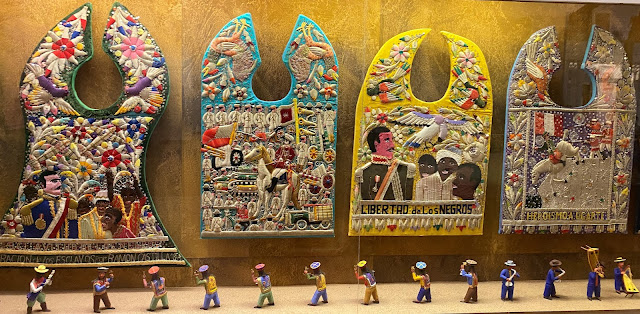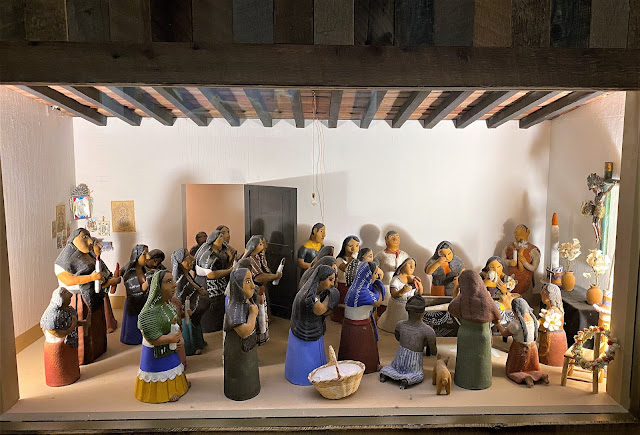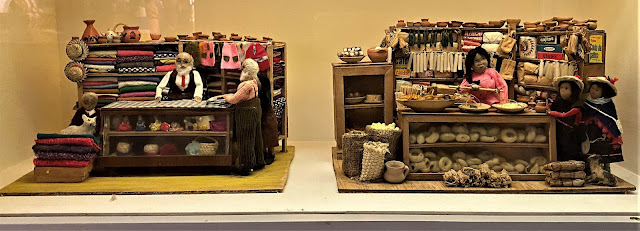June 29, 2021
I had no idea what Santa Fe's Museum of International Folk Art was. I had never heard of it when Bob added it to our itinerary. He knows I love folk art and art museums in general, and so the name attracted his attention.
It was raining when we got to the museum complex known as "Museum Hill." Four museums are on the site: the Museum of Spanish Colonial Art, the Museum of Indian Arts & Culture, the Wheelwright Museum of the American Indian, and the Museum of International Folk Art. In addition, there is also the Botanical Garden at Museum Hill. So much to see and so little time!
You could easily spend two days on this hill, but we only had one afternoon, so we made our way to the Folk Art Museum.
At first, it seemed like a normal art museum. We paid our entrance fee and started down a hallway, passing
 |
| Triple Eyes (2007) by Alexander H. Girard |
When we entered the main exhibit room, however, we discovered an art museum unlike any other we have visited. It was a very large room, warehouse sized, absolutely crammed with dioramas of scenes from various cultures along with dolls, masks, religious folk art, costumes, toys, and so on. More than 100 countries are represented. It is an eye-popping collection. In fact, the Folk Art Museum houses the largest collection of folk art in the world. There are more than 135,000 artifacts, about 10% of which are on display at any given time. I could have spent the entire day in this huge room with its warren of displays. Bob, on the other hand, was a bit overwhelmed. It's more my thing than his.
Here is a sampling of a few of my favorites. It may seem like a lot of photos, but it is a small fraction of what I saw. I am not going to try to group them together by type because that is not how I experienced the museum.
My only complaint is that there is no identifying plaque-age to go along with the display. To get information, you have to go online using a link or app or something, and no one seemed to be available to tell us how to do that. I would have appreciated even knowing the country of origin for the works.
Since coming home, I've found a few details about some of the displays, such as this Polish nativity.
The wisemen have made it about half-way up to the manger. Again, figures in the foreground are large and get increasingly smaller on the way to the manger to create that feeling of distance.
A tailor's shop and a general store:
African or Middle Eastern scene:
A close-up of the right side of the diorama shows an angel, some people, and animals. The faces are fantastic.
Um, sometimes the proportions don't work out too well.
Another of my favorites is this Mexican clay nativity:
Chatting women.
This looks like a village in Asia. Note the dragon boat in the center.
Dolls from around the world, each made of hundreds (thousands?) of beads:
A delicious dinner ready to be eaten. Just ignore that giant cockroach on the wall (bottom right of photo).
I can't tell where this display is from. The demons on top don't seem to go with the Mexican diorama.
Crazy heads on top of a grouping of straw dolls.
This mermaid from Oaxaca, Mexico, is actually a painted bottle. I think her head is the spout.
And that is just a fraction of what is in the cavernous room I call the Diorama Exhibition. The museum has other sections, although none were quite as exciting to me. We exited the dioramas through this door adorned with an Inuit carving.
The center of the building, a passage between worlds.
Besides the permanent collection, the museum has space for traveling exhibits. The first such exhibit we visited was entitled "From Combat to Carpet: The Art of Afghan War Rugs." These handwoven rugs are adaptations of traditional rugs made by Afghani artisans. They were made specifically for occupying military personnel, journalists, contemporary art curators, and other foreigners. The show the innovative skills of the weavers, but also the long, hard history of foreign involvement in Afghanistan.
Most of the rugs were created by unknown artists.
 |
| Dollar Bill Rug and Hundred-dollar Bill Rug (2001) |
 |
| Rug with Map of Afghanistan and Uncle Sam Hat (after 2001) |
 |
| Cityscape Rug [possibly New York] (1994) |
 |
| Rug with Military Base (1994) |
 |
| Cityscape Rug [Possibly Germany] (mid-1980s) |
 |
| Rug with Border of Automatic Rifles (1985) |
 |
| 9-11 Commemorative Rugs from Afghanistan and Pakistan (after 2001) |
There was another traveling display of unique musical instruments, such is this guitar made from an armadillo shell.
Check out this license plate guitar (right) and its amplifier (left).

There were several unique pieces of furniture. I love this "Day of the Dead" altar by Luis Tapia (2017)
That's the Virgin of Guadalupe on the bottom panel, and aren't the skeleton musicians wonderful?
I need this for a Halloween decoration: Death Cart (2010) by Mario Vargas of Taos, New Mexico.
The next gallery we explored had a show from "The International Coalition of the Sites of Conscience." According to their signage, they are "a global network of historic sites, museums and memory initiatives that connect past struggles to today's movements for human rights." Most of the displays had something to do with the Covid-19 Pandemic. Next to the first big diorama room, this was my favorite exhibit.
From South Africa:
 |
| Social Distance by Selinah Makwana |
The Virgin of Guadalupe! From California:
 |
| Has tu Parte (Do Your Part) by Carmen Abelleira |
From New Mexico (and done in the style of the New Mexican tradition of religious imagery):
 |
| La Sagrada Papel (The Holy Paper) by Arthur Lopez |
Face masks from Mississippi, Illinois, and Mississippi:
 |
| Dashiki Bonnet and Mask Ensemble by Aloha Glamour, Fatia Mask-Headramp Ensemble by Akese Stylelines, and Sun Rays Mask-Headwrap Ensemble by Aloha Glamour |
Home as a safe place: the sink is an altar with hand sanitizer and soap. The virus is floating outside the kitchen window, but saints surround the window, adding protection. A bottle of Corona beer plays on the misunderstood fear of the word corona.
 |
| 2020 Altar Vision by Arthur Lopez |
During the 17th century, doctors wore beak-like masks to protect themselves from the plague. The masks could hold some 55 herbs and aromatics intended to ward off the "bad air" that they believed caused the disease.
 |
| Plague Doctor Carnival Costume by Atelier Semenzato Paolo |
This one is re-created with traditional Cree materials and beadwork.
 |
| Beaded Plague Doctor Mask by Dolore Gull |
My favorite was this poster by Hatch Show Print, a letterpress shop in Nashville.
The final exhibit we viewed was entitled "Yōkai: Ghosts and Demons of Japan." These fellows look like thing out of my worst nighmares.

A whole art museum in New Mexico without a single Frida sighting? I had to go to the gift shop to find her. She is everywhere in the gift shop.
She frames a mirror:
She is on pillows:
She is on lots of doo-dads:
There are even Frida coloring books and children's books:
Apparently, Frida has great commercial appeal. 😄
Overall, WHAT A FIND. I have never seen another museum quite like this one. I can't wait to go again with my daughter in about six weeks. In fact, it was visiting this museum that caused me to propose a "Girls' Trip" together to Santa Fe in the fall.










































































This museum was waaaaaay toooooo much. Your normal art museum has some large white walls and a few paintings on each wall, well labeled, you know what you're looking at. That is manageable. This museum was like the inside of Santa's bag. There was good stuff, but it was stuffed into every nook and cranny, often difficult to see, not labeled, difficult to determine where one exhibit ended and another started, and even what row to go down and where you'd been and not been. To use another metaphor, it was like a hoarder had stuffed it all into a rat maze, nothing was labeled, and you just had to do your best. As a result, I blazed my way through in record time, no idea if I saw everything (didn't care) and found a nice bench in the hall and googled on my phone. I'm not sure I've ever had that feeling in a museum before. I can say that much of it was pretty cool. If there'd been a tenth of what was in the room, spread out and labeled, I could have spent much more time.
ReplyDeleteThis sounds exactly like what you say about IKEA! :)
Delete